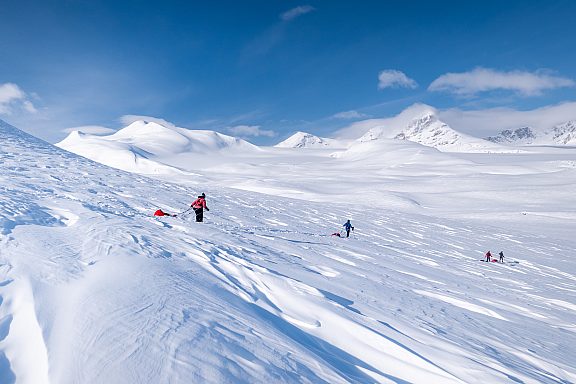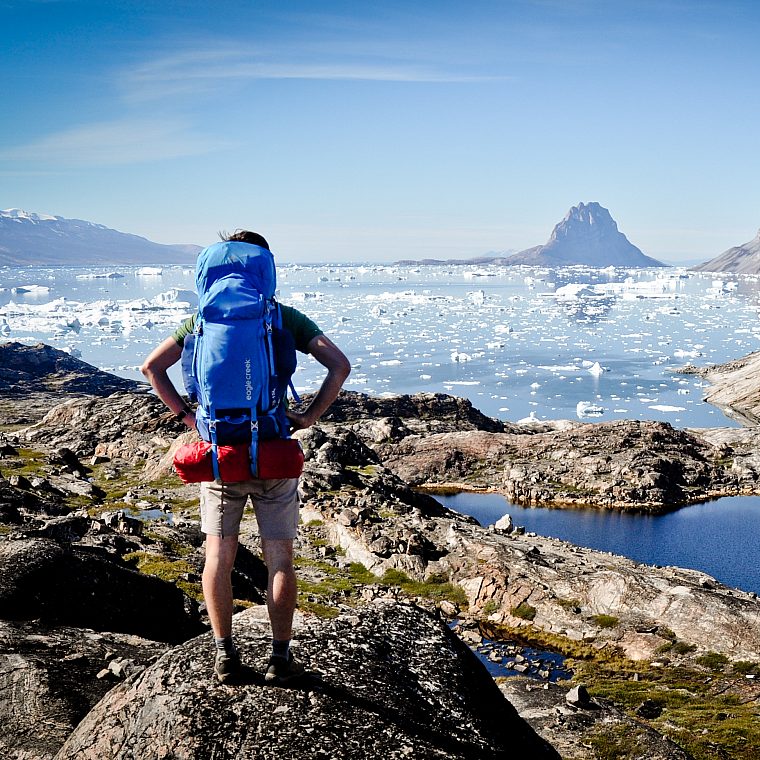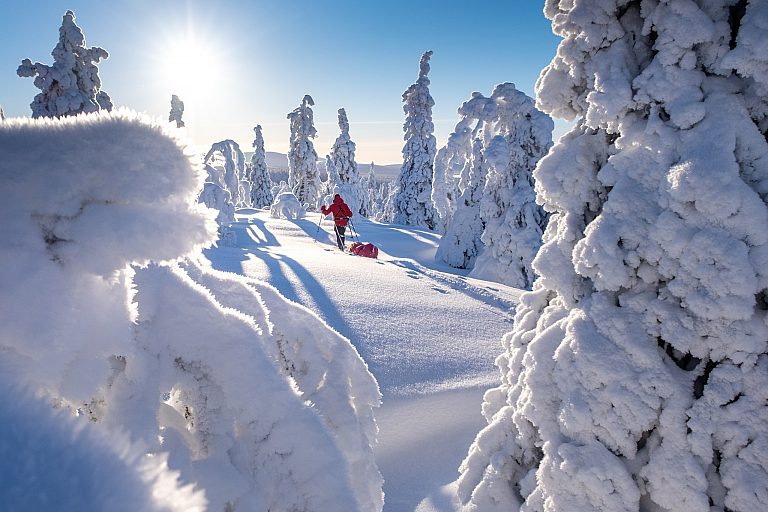
Pulk Expeditions
With our winter trips, we experience total immersion in the magical winter atmosphere of Lapland and the High Arctic. During the early winter months of January and February, the intimate fjells of Finnish Lapland beckon, with their snow-packed 'marshmallow trees' and polar blue twilight skies. As the daylight hours grow longer and the sun climbs higher in March, we head to the more mountainous Norwegian and Swedish fjells of Lapland.
Warmly clad and well-equipped for the cold, we haul our pulks through the arctic wilderness on cross-country skis or snowshoes. The barren landscapes are ever-inspiring: sometimes beauty is observed in nature's subtlety and serenity; at other times the harsh and changeable arctic conditions keep us honest and grounded - with the prickle of cold air on your cheeks, you are bound to feel alive.
Our objective is the same every day: reach the next cozy mountain hut or isolated campsite, and be immersed in the arctic scenery along the way. Straightforward as it may sound, it is exactly this simplicity that we seek. During the long evenings, we crank up the woodfire and enjoy hot 3-course dinners using fresh ingredients we carry with us - the benefit of winter expeditions and using pulks.
When the night descends, we hope for the ultimate reward after a challenging day out: a magical demonstration of Northern Lights - which we will be lucky enough to experience away from the lights of tourist hotels and civilisation.
Cross-country skis
On most of our expeditions, we use cross-country touring skis. These are ideal for long-haul trips in areas with difficult snow conditions (deep snow) and with no tracks. These skis are stable yet lightweight, and ideal for "hiking" long daily distances on skis.
All our skis are outfitted with skins, which will help you when ascending slopes, while also providing extra stability. This is the most "natural" form of winter trekking in the rolling terrain of Northern Scandinavia. Prior skiing experience is not required for most trips. Your mental attitude, however, is important.
The long duration of our trips (at least 6 days out in the wilderness in full autonomy) in combination with the cold, guarantee winter trekking at its purest.
Snowshoes
Snowshoes are a perfect alternative for skis for your first sporty winter experience in Finnish Lapland, or during more strenuous treks where the terrain is unsuitable or dangerous for skis (for example in the chaotic topography of Iceland's volcanic areas). Snowshoes are used in combination with warm winter boots. A classic mountain hiking boot is usually insufficient in terms of insulation because of the intense cold. The snowshoes provide excellent grip on icy terrain.
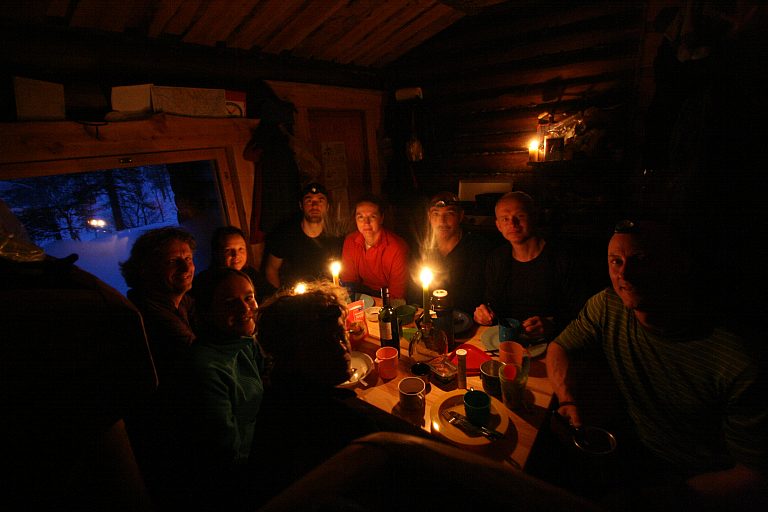
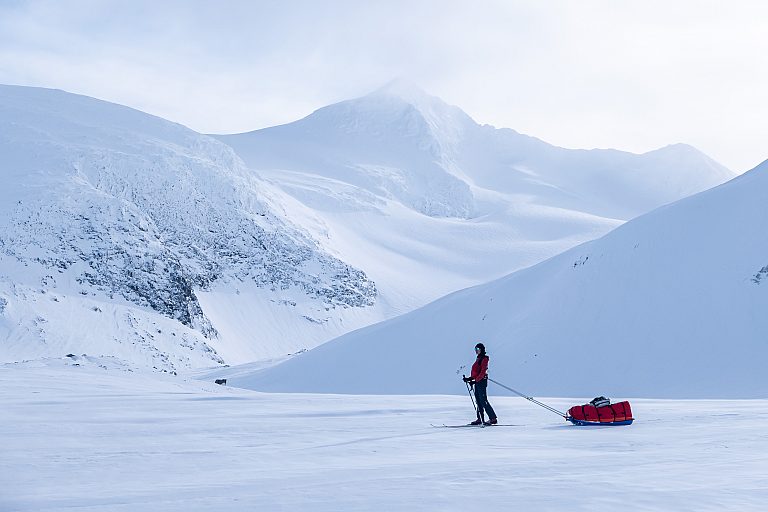
Cozy mountain cabins
We spend the night in small, cozy mountain cabins, in spectacular wilderness locations. A woodfire stove ensures we are warm inside and can fully relax and unwind. Some huts are quite primitive (such as in Finland), while others are more luxurious and spacious (Norway, Sweden), sometimes with a wilderness sauna. There is no electricity, and we get water from a nearby stream or by melting snow. Cell phone coverage is minimal to absent. In Svalbard, we will sleep in tents under the glow of the midnight sun.
Alongside the time spent outside, hut life is also a special part of the expedition. Everybody contributes to daily tasks like fetching wood and water, melting snow, dishwashing, digging the pulks out of the snow in the morning etc. We spend the evening reminiscing about the day around the candlelight.
Food fit for a King (or Queen!)
Whenever possible, we cook fresh food. Outside temperatures are below zero both day and night, which means our pulks serve as 'transportable freezers'. In the morning, we enjoy cereal/muesli or cooked breakfasts (bacon and eggs, pancakes and french toast) in the morning, a variety of high-calorie snacks during the day, and extensive 3-course dinners in the evening.
During camping expeditions we eat freeze-dried food from the best brands, always tested in advance by our Into the Arctic team.
Prime locations for aurora
Miles away from any light pollution, and in areas right under the "aurora belt", with good weather, the likelihood of seeing Northern lights is high.
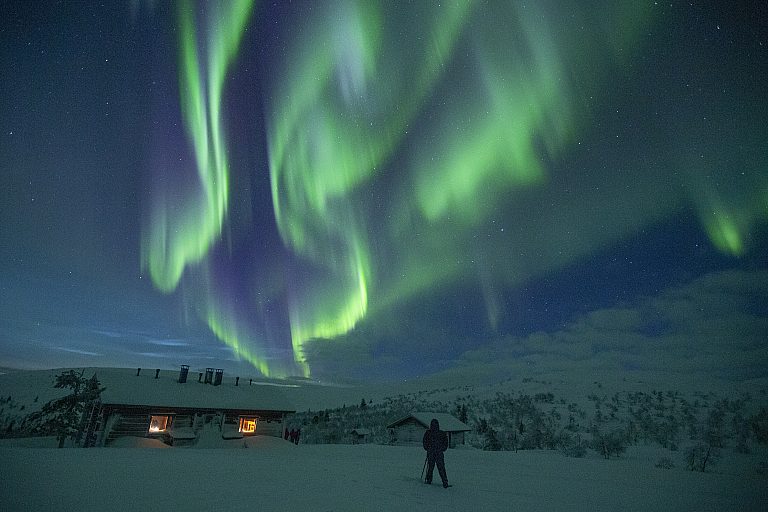
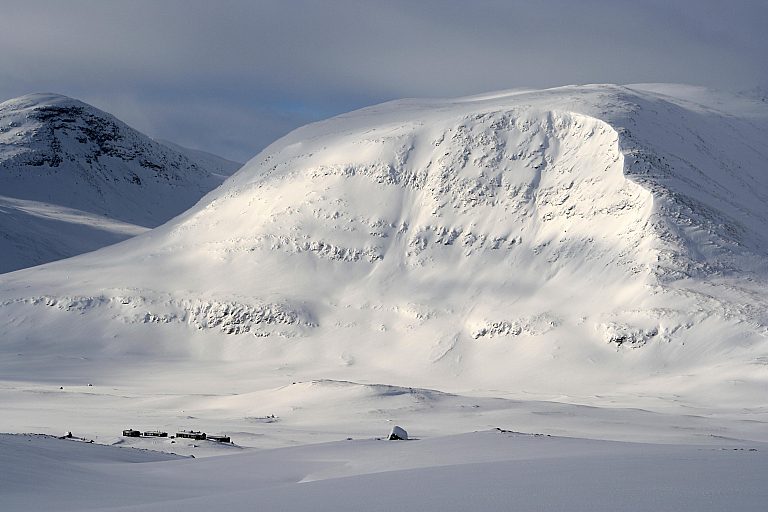
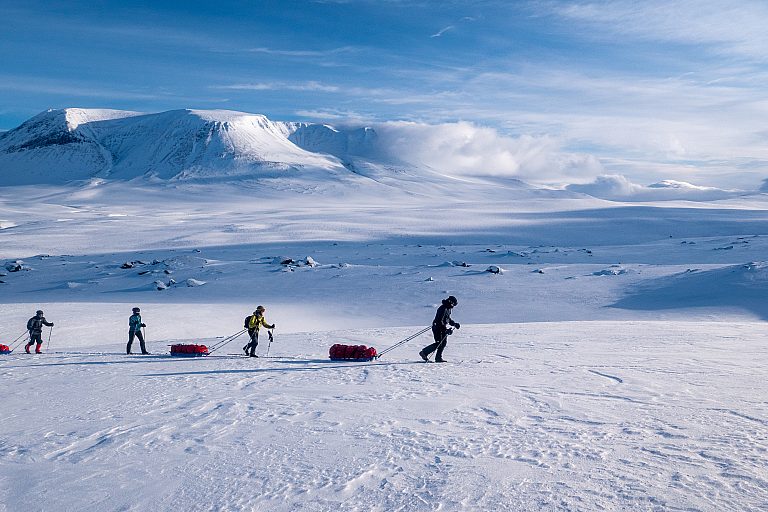
Safety
Safety is always a primary concern for Into the Arctic. Iridium satellite communication, Wilderness First Aid Training, emergency beacons and detailed planning for every expedition are standard practices.
Rock-solid logistics and terrain knowledge
Into the Arctic uses state-of-the-art expedition gear. We currently manage a stock of 41 Fjellpulken and Snowsled pulks, 54 pairs of cross-country Madshus and Alpina skis, a total of 147 pairs of ski boots, Tubbs snowshoes, 22 Hilleberg tents, and a collection of RAB down equipment. We operate partly from our own, permanent gear storages in the Nordics. Into the Arctic has direct communication lines with all relevant contacts- a network that we have slowly built up over the years. Every expedition on the field has extensive 24/7 backup support from the office, with daily weather updates through satellite communication.
Throughout the years, we have visited every destination multiple times, leading to a massive inventory of routes. This means we can always adjust our route plan according to the weather conditions of the day, ensuring a safe and enjoyable day out. In uncomfortable windchill conditions for example, we might choose to follow a lower route with more shelter from the trees; but in good conditions, we might head for a west-facing slope just above the treeline to try to catch the last golden sun rays of the day.
Pre-trip meeting
Prior to every trip, we organise a meeting at our Into the Arctic basecamp in Ghent, Belgium to give you the opportunity to meet your guide and trip companions, and to go through the itinerary and gear list in more detail. You will also be able to try ski boots and down clothing. For the winter expeditions, this meeting will be held during a weekend in November or December.
Gear tips & tricks
Our passionate guides will assist and advise you on buying your personal gear. We often recommend merino thermals from Woolpower, and strong and waterproof shells from brands like Arcteryx, Mammut, The North Face, RAB etc. Our own down clothing is mostly sourced from RAB.
Rental gear
We have a huge stock of rental gear: down mittens, down jackets, sleeping bags, winter boots, ... all suited for your expedition.






1 -
©
2 -
© Brent d'Hooge
3 -
© Willem Vandoorne
4 -
© Brent d'Hooge
5 -
© Brent d'Hooge
6 -
© Willem Vandoorne
